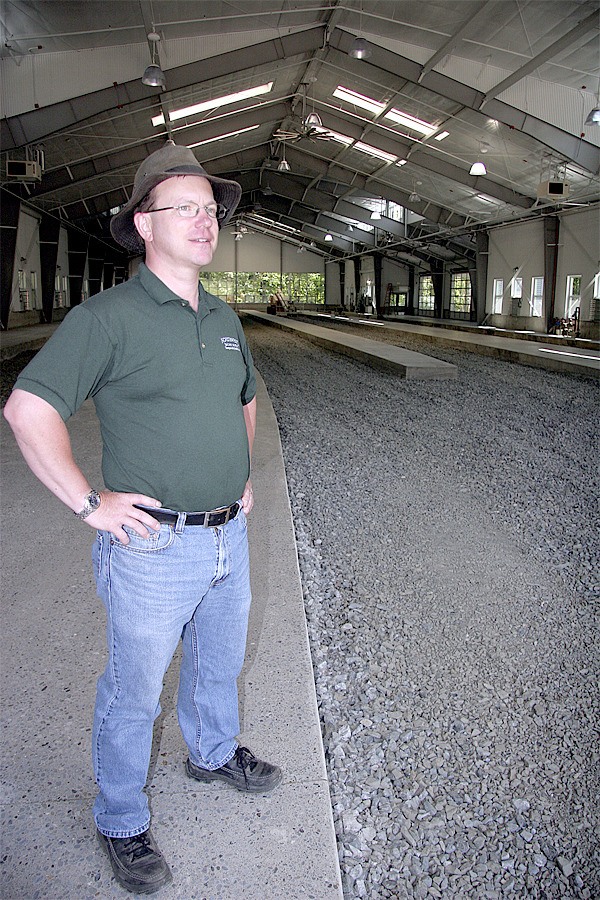Tapping floorboards into place aboard the Northwest Railway Museum’s long, lean car No. 218, volunteer Russ Stegner is restoring history, a plank at a time.
The gray-bearded Stegner has loved trains since childhood. Now, at age 73, his efforts at the museum’s Conservation and Restoration Center, or CRC, preserve the legacy of the rails while keeping him in shape, too.
The 1912 Barney and Smith 218 car was the first vehicle in the doors of the CRC, built four years ago to give volunteers a place to restore venerable but deteriorating cars and locomotives to their original glory.
This summer, the Northwest Railway Museum’s campus makes its next transformation, with the addition of the new Train Shed Exhibit Building. Construction of the shed is nearly complete; once finishing touches are done, the building will shelter all vulnerable cars in the museum’s collection, safeguarding them from further decay.
“If it had been here 50 years ago, we wouldn’t be doing this,” said volunteer Bob Miller. “We would have been able to preserve a lot of the wooden artifacts we have.”
New shed
Wick Constructors of Bellevue are on the final punch list for the $4 million, 25,000-square-foot shed, which covers half an acre.
“This is a big deal. This is very positive,” said Richard Anderson, the railway museum’s executive director. Construction began last July, just months after a devastating flood hammered museum facilities. Since then, the museum started an annual gala benefit and took over organization of Snoqualmie Railroad Days.
The last 18 months, Anderson said, have been more eventful than any time in the previous 18 years.
Workers will soon lay 1,200 feet of track to bring cars into the building, which will enter through three huge steel-and-glass roll-up doors, the largest of which weighs six tons.
Besides cars, exhibits will be spread throughout the building. Tracks lead to a rear plaza, where the museum envisions outdoor receptions and programs. The collection inside will change over time, giving visitors incentive to return.
Even after weeks of hot weather, the shed’s insulated steel walls keep the temperature inside cool. Circulating fans and wall louvres keep air flowing to minimize mold and damp. Special windows block damaging ultraviolet rays.
Once complete, the shed will transform downtown Snoqualmie, housing rusty cars and drawing sightseers who now roam a roadside trail along Highway 202.
Visitors will board trains at the North Bend and Snoqualmie Depots, disembarking at the shed for tours of that facility and the CRC.
Some cars and signs will remain along Highway 202.
“There will still be a reason for people to stop and walk the trail,” Anderson said. But with the exhibit building, “we’ll be able to provide a much fuller experience, play a greater role as an educational institution.
“We’ll be playing a role in the economic vitality of downtown Snoqualmie,” he added. “We’re a destination in our own right.”
The shed “will be a real attraction,” said Fritz Ribary, exeuctive director of the Snoqualmie Valley Chamber of Commerce.
Ribary said he is amazed by how often he sees sightseers walking the roadside trail, viewing the cars. The shed allows them to see the collection in all weather.
“It’ll give people an opportunity to have more time to view the engines and cars,” Ribary said. “Hopefully, they’ll be able to run a train for people who would like to see that during the week.”
Future plans
Post-construction, the museum now focuses on restoration of the Messenger of Peace, a century-old rolling chapel. The museum recently received a $50,000 Partners in Preservation grant to bring the Messenger, once crumbling on the Pacific Coast, to its heydey appearance.
When finished, restored cars including the Messenger, the 218 car and its White River Lumber Co. Caboose 001 will be showcased in the exhibit building. A ribbon cutting for sponsors and donators is planned for autumn.
The shed is only the second piece of a multi-building campus vision, which has its roots in the museum’s incorporation in 1957. The site had been selected as far back as 2000, with plans for a conservation center and train barn.
Still to come are a library, archive and classroom building and a possible roundhouse.
“We’re already working on the library,” Anderson said. “It’s a challenging environment to be fundraising in. But we have a great plan.”
“We’re developing a destination campus,” he added. “We’ll be offering a full experience here.”
The finished campus will contribute to the local body of knowledge on railroad history.
“Almost everybody is connected to the railroad in some way,” Anderson said. “This part of the country was opened up by the railroad.”



